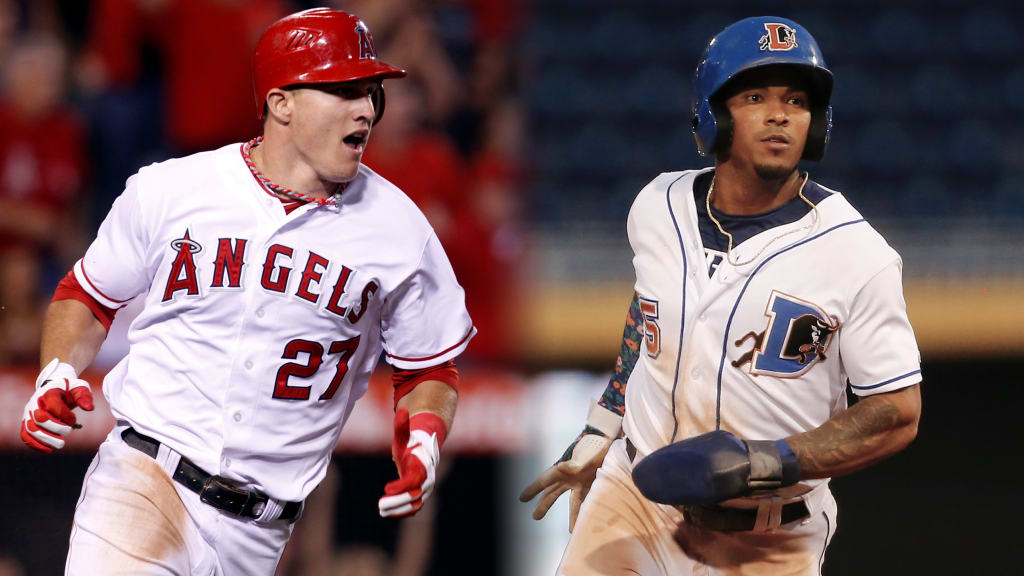
In case you haven’t heard, Wander Franco is heading to the Major Leagues on Tuesday.
He becomes the first Major Leaguer born in the year 2001, and he will be the only 20-year-old in The Show upon his arrival with Tampa Bay. Being in a group of one is as exclusive as it gets, but open this up to recent history and the switch-hitting infielder is joining a club of 20-year-old Major League rookie position players that runs the gamut of the baseball experience.
There are some who took off immediately. There are some who stumbled out of the blocks. There are others who were just finding their footing, didn’t find immediate success early on but built the foundations for special careers. Success or failure at such a young age is far from a be-all, end-all determination, but a look at which players made it to The Show that early can give us something of a roadmap for where Franco may be headed.
These are some notable 20-year-old rookie position players from the expansion era (1961 and beyond):
The gold standard
Mike Trout, Angels OF, 2012
The “rookie” stipulation here is important right from the jump. (It’s why you won’t find Alex Rodriguez, Ken Griffey Jr. or Juan Soto among others on this list, since they graduated before 20.) Trout came up to the Majors in his age-19 season in 2011 but looked far from his normally dominant self with a .672 OPS in 40 games. He moved to Triple-A Salt Lake for 20 games the following spring, batted .403 with a 1.091 OPS, and returned to the bigs for good at 20 years old on April 28, 2012. What followed was one of the most impressive rookie campaigns of all time. Trout hit .326/.399/.564 with 30 homers that summer for the Halos. His 49 steals led the entire Majors, and his 10.1 fWAR tied with Buster Posey for the best in baseball. It also led to one of the most famous MVP debates of the last decade. Trout, who captured AL Rookie of the Year in a rout, finished second to Miguel Cabrera, winner of the first Triple Crown since 1967. The Angels superstar has won three MVPs of his own since on his way to a surefire Hall of Fame career.
No one is Mike Trout. That can’t be stated enough. But for a highly-rated prospect entering the Majors with a ton of hype, Franco has a good role model in the center fielder as to what is possible at such a young age.
Other notables
Johnny Bench, Reds C, 1968
Like Trout, Bench came up for a cup of coffee in his age-19 season in 1967 but was far from his eventual star status, going 14-for-86 (.163) with 19 strikeouts in 26 games. But he made enough of an impression -- first as the Sporting News Minor League Player of the Year at Triple-A Buffalo in 1967 and later in the Majors -- to earn a full-time spot in 1968 once Cincinnati traded away previous starting backstop Johnny Edwards. Bench made the most of his opportunity as a 20-year-old by winning NL Rookie of the Year honors on top of an All-Star spot and a Gold Glove behind the plate. He hit .275/.311/.433 with 15 homers, two triples and 40 doubles. Two years later, he would win his first of two NL MVP Awards in his age-22 campaign. Catchers typically take longer to develop than other position players, but by showing he had the goods on both sides of the ball, Bench was able to secure a spot at the top level early and stay there as arguably the game’s greatest catcher.
Jason Heyward, Braves OF, 2010
Admired for patience at the plate and impressive defense in right field, Heyward was arguably the top prospect in baseball entering his age-20 season in 2010, and Atlanta thought he was ready enough to become an Opening Day starter that year. The left-handed slugger rewarded that confidence with a homer on his first Major League swing on April 5, and he never much looked back the rest of the way. Heyward finished with a .277/.393/.456 line, 18 homers and 11 steals in 142 games with the Braves that first season. He was a National League All-Star (though a thumb injury kept him out of the game) and narrowly lost the NL Rookie of the Year Award to Buster Posey. His OBP and 4.6 fWAR remain second-highest among 20-year-old rookie hitters since 1961.
Recent stars
Ronald Acuña Jr., Braves OF, 2018
This section is going to be heavy on the Juniors. (Fits right in with baseball today, huh?) Acuña ripped through three levels of the Minors during his age-19 season in 2017 and was the breakout prospect of that year, showcasing a power-speed combo rarely seen in the lower levels by players of any age. The Braves still opened him at Triple-A Gwinnett to begin his age-20 season, only to bring him up in late April. The right-handed slugger looked like a veteran, hitting .293/.366/.552 with 26 homers and 16 steals in 111 games. He held off the 19-year-old Soto in the NL Rookie of the Year race and even finished 12th in MVP voting after helping Atlanta reach its first postseason since 2013. He finished three steals shy of the 40-40 club one season later and has a decent chance to break through to that group in 2021.
Fernando Tatis Jr., Padres SS, 2019
The Padres wasted no time in pushing Tatis to the Majors two years ago, giving him his debut on Opening Day despite his having never played above Double-A. The shortstop was even more electric than advertised with 22 homers, 16 steals and a .317/.379/.590 line. In fact, his .590 slugging percentage was the highest among 20-year-olds with at least 200 plate appearances, just beating out Trout (.564) and Acuña (.552). Unfortunately, a back injury limited Tatis to only 84 games, and as such, he finished third in NL Rookie of the Year behind Pete Alonso and Mike Soroka. But the buzz that Tatis generated that first season hasn’t gotten any quieter now in his age-22 season.
Vladimir Guerrero Jr., Blue Jays 3B, 2019
Franco’s ascent to the Majors is the most exciting promotion to the top level since Toronto called up Guerrero in late April 2019. The son of the Hall of Famer flirted with .400 for much of the 2018 season and showed a lot of pop in his first turn with Triple-A Buffalo the following spring. His Major League numbers that first summer were respectable -- .272/.339/.433, 15 homers, 105 wRC+ -- but they didn’t scream immediate phenom. We know things have changed since then, as Guerrero is an AL MVP candidate and arguably the Majors’ best hitter right now. His age-20 season and early career serves as a good reminder that development does not stop once a player leaves the Minors and that players the same age as college sophomores and juniors deserve some slack.
Other recent notable 20-year-old rookie hitters
Xander Bogaerts (2013), Carlos Correa (2015), Ozzie Albies (2017), Rafael Devers (2017), Victor Robles (2017), Luis Garcia (2020)
Later bloomers
Rickey Henderson, Athletics OF, 1979
Speaking of 20-year-olds who needed to grow into superstardom, you won’t find better examples than this section. A fourth-round pick in 1976, Henderson sprinted his way through the Minor Leagues, stealing at least 80 bags in both the 1977 and 1978 seasons. With the A’s in the midst of a down 1979 campaign, the club decided to bring up the speedster for his debut on June 24. It was an aggressive move that didn’t pay off initially. Sure, Henderson swiped 33 bags in 89 games -- only Trout (49) has stolen more as a 20-year-old rookie -- but he produced just a .338 OBP and .675 OPS, far cries from his eventual career marks of .401 and .820. The Oakland native was actually below-replacement-level at 20-years with a -0.7 fWAR in 1979. That didn’t last long, of course. Henderson swiped 100 bags one year later on his way to his first All-Star appearance, and the Hall of Famer didn’t produce an OBP below .350 again until 2003. That was his age-44 season.
Cal Ripken Jr., Orioles SS, 1981
This is a small sample, so take this with necessary grains of salt. Ripken pushed to the Majors in August 1981, shortly following the players’ strike, after hitting 23 homers and posting a .919 OPS at Triple-A Rochester, but he struggled to make an immediate impact at the top level. The 1978 second-rounder went 5-for-39 (.128) with no extra-base hits over 40 games in his age-20 season. In a twist from the rest of his career, a lack of consistent playing time kept Ripken from getting into a rhythm during his first trip to Baltimore. Luckily for him, that lack of at-bats helped him maintain his rookie status, and he claimed the AL Rookie of the Year award a year later, having hit 28 homers with a .792 OPS in 160 games. The rest is history.
Gary Sheffield, Brewers SS, 1989
Sheffield likely knew a thing or two about playing in an age-20 season from having seen his uncle Dwight Gooden win an NL Cy Young Award at that age in 1985. The hard-swinging right-handed slugger had already gotten off to a rough Major League start in 1988 with a .238 average and .695 OPS over 24 games in his age-19 campaign. His 1989 campaign wasn’t much better. Sheffield hit .247/.303/.337 with five homers in 95 games in his age-20 season with Milwaukee. Sheffield was below-replacement-level as well with a -0.4 fWAR. The best thing about his season may have been his near-even 33/27 K/BB ratio. The 1986 sixth overall pick posted a wRC+ above 100 only once in four seasons with the Brewers, and his breakthrough didn’t come until 1992 when he batted .330 and clubbed 33 homers following a trade to the Padres.
Cautionary tales
Jack Heidemann, Indians, SS, 1970
It would stand to reason that players who reach the Majors at 20 are talented enough to sustain productive careers at the top level, but that isn’t always the case. Take, for instance, the extreme example of Heidemann. The 1967 11th overall pick was so highly regarded in the Minors -- especially on the defensive side -- that Cleveland made him one of its 15 protected players in the 1969 expansion draft before he even played above Class A ball. One year later after time at Triple-A Portland, Heidemann became a full-time Major Leaguer in 1970 at just 20 years old, but his bat wasn’t quite up to snuff. Heidemann hit only .211/.265/.292 with six homers in 133 games in his rookie year. His -2.2 fWAR was the worst of any 20-year-old rookie since 1961, though it’s possible modern analytics could have helped his defensive value. He never played more than 81 games in a Major League season again and was out of the Majors for good after his age-27 season in 1977.
Dalton Jones, Red Sox 2B, 1964
Jones was signed for $60,000 out of Baton Rogue in 1961 (roughly $500,000 in today’s money) and moved quickly through the Boston system, arriving in 1964 after only three Minor League seasons. He was likely going to be overshadowed as a rookie on that 1964 team by the even-younger local kid Tony Conigliaro, but his play didn’t help matters. Jones hit .230/.274/.342 with six homers in 118 games, a season that was worth -1.3 fWAR. Jones was an above-average hitter only once in his career -- during Boston’s 1967 Impossible Dream season -- but even then he served primarily as a bench option. Jones finished with a career 77 wRC+ and -3.6 fWAR over his nine-season career that ended after his age-28 season in 1972.
